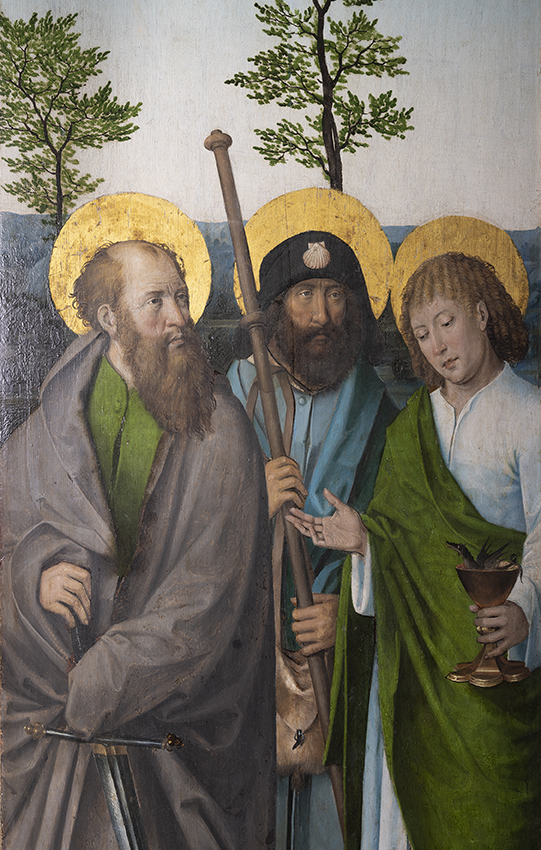The Bollnäs altarpiece, created in the workshop of Michel Sittow, visits its place of birth 500 years later

The exhibition Michel Sittow in the North? Altarpieces in Dialogue, opening on 4 May in the Niguliste Museum, displays, for the first time, the activities and possible works of Michel Sittow’s (ca 1469–1525) Tallinn workshop in dialogue with the other international masters operating in Tallinn at the beginning of the 16th century.
The focal point of the exhibition is the magnificent Bollnäs Holy Kinship altarpiece from northern Sweden, which was, with high probability, made in Michel Sittow’s Tallinn workshop in 1510‒1520. During the same period, Michel Sittow also painted the outer wings of the Tallinn Passion altarpiece. The exhibition in the Niguliste Museum reveals the stories and meanings of the two works of art and views them in the broader context of other works created during the same time period in late medieval Tallinn and the surrounding areas.
“The sculptural section of the Bollnäs altarpiece, executed with exceptional skill, stylistically relates to a number of works surviving in Tallinn, motivating a closer look at the circle of wood and stone carvers active in Tallinn in the 16th century and their co-operation. The main focus of this research is on the works of art and a comprehensive, versatile and dialogical analysis of them. Written sources play a vital role as well, since they support the ties between the commissioners and creators of the period,” said Merike Kurisoo, the curator of the exhibition and leader of the research project.
In this context, the key work is the cenotaph for Hans Pawels and its sculptures on the eastern wall of the Lady Chapel at St Olaf’s Church. The life-size sculptures of Wolter von Plettenberg, the Master of the Livonian Order, and the Virgin Mary, which were located in the Riga Castle, can probably be attributed to the same masters. The arrival in Tallinn of such works as the Bollnäs altarpiece and the life-size carved sculpture of Plettenberg, now a part of the collection of the National History Museum of Latvia, makes the exhibition extraordinary. Such rare and complex works of art very rarely travel and their arrival in their “city of birth” is a truly unique event.
In 2018, the first monographic exhibition introducing Michel Sittow’s work, Michel Sittow. Estonian Painter at the Courts of Renaissance Europe, took place through the cooperation of the Art Museum of Estonia and the National Gallery of Art in Washington. The exhibition displayed 19 works attributed to Sittow from prominent museums around the world. At that time, the exhibition primarily displayed to the public the more elitist section of the artist’s work. The paintings on the outer wings of the Tallinn Passion altarpiece were exhibited as the only possible works by Sittow from his Tallinn period. “Displayed together in the same space, the exhibition showed the need for further investigation of the artist’s work, as well as acknowledging the different contexts of Sittow’s artistic career, i.e. his activities as a portrait painter in royal courts and as an artist-craftsman in a Hanseatic town,” the curator of the exhibition Greta Koppel said, the exhibition in Niguliste being a significant continuation of the first Sittow exhibition five years ago.
The renowned Tallinn-born artist Michel Sittow (ca 1469–1525), who was active in the royal courts of Europe during the Late Middle Ages, lived and worked in his home town for more than fifteen years. In the courts of Southern and Northern Europe, he painted portraits of kings and high ranking noblemen; in Tallinn, he undertook commissions from local merchants and the city government, as well as churches of the Nordic countries.
The exhibition Michel Sittow in the North? Altarpieces in Dialogue is a part of the international research project of the same name, started in 2021, involving the Art Museum of Estonia, the Hälsingland Museum and the Church of Sweden. For the first time, it brings together works of art from Estonia, Sweden, Finland and Latvia which were probably created in Tallinn in the first quarter of the 16th century. A richly illustrated catalogue complements the exhibition. A diverse public programme accompanies the exposition, with the opening event on 6 May, when the international team of curators introduces the exhibition. The four curators will conduct tours in three languages.
The opening event of the exhibition is the visit to the museum by their Majesties King Carl XVI Gustaf and Queen Silvia of Sweden, together with the President of the Republic of Estonia Alar Karis and Mrs Sirje Karis during the Swedish state visit on 2 May 2023.
The exhibition is open until 5 November 2023.
Chief curator of the exhibition: Merike Kurisoo (Art Museum of Estonia)
Curators: Greta Koppel (Art Museum of Estonia), Lars Nylander (Hälsingland Museum) and Jan Friedrich Richter (Berlin State Museums)
Exhibition design: Liis Lindvere and Villu Plink
Graphic design: Tuuli Aule
We thank the lenders of the works of art: the Bollnäs Congregation, the Church of Sweden, the National Museum of Finland, the National History Museum of Latvia, the Tallinn City Museum, the Tallinn Culture & Sports Department and the EELC Tallinn Holy Spirit Congregation